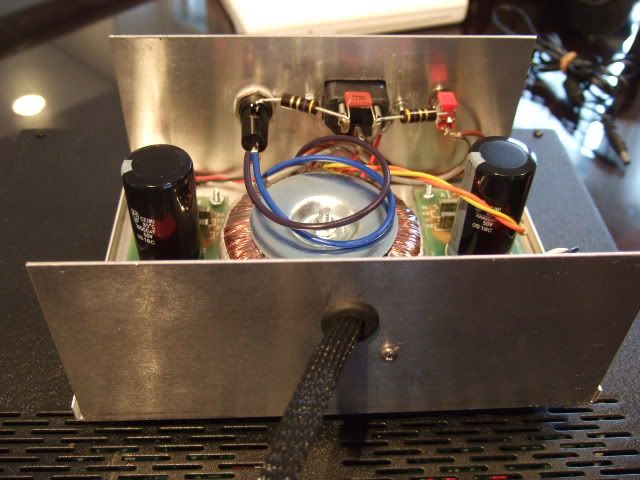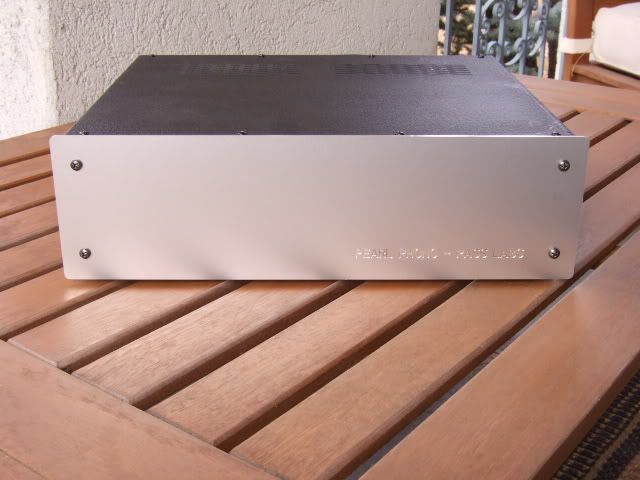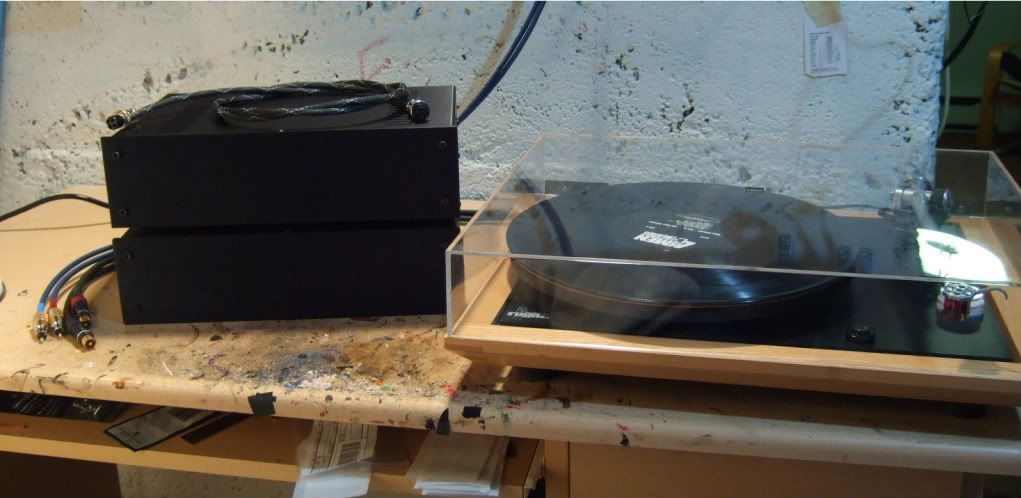Ugly, can i use a shoe box then?
You should see my old Dyna pat 5 box/Pearl2 power supply...talk about re purposed... out of sight out of mind until one of the store's smaller boxes replace it...
Russellc
Here is my point -

PSU Pearl 1. Plain aluminum box, perforated cover (not shown). It's useful as an enclosure, but not very attractive.

I don't like to have near this chassis - this looks great!

Here is my Pearl 2 - the matching PSU/RIAA boxes look fantastic when stacked. Really quite nice. It's a shame, because the best performance of the phonostage is when the PSU is quite a distance away from the RIAA.

PSU Pearl 1. Plain aluminum box, perforated cover (not shown). It's useful as an enclosure, but not very attractive.

I don't like to have near this chassis - this looks great!

Here is my Pearl 2 - the matching PSU/RIAA boxes look fantastic when stacked. Really quite nice. It's a shame, because the best performance of the phonostage is when the PSU is quite a distance away from the RIAA.
Would think that there must be a way to shield the hum and have in one enclosure. A double steel box?. Have to experiment. The TT is not introducing the hum? and its power cord is very close to the signal cable, so why is that not the major contributor of hum? Possible to look at high end stereo's service manuals to see how they shield/wire/etc.
Just got a back plate assembly, from a scrapped Pioneer SX-1050, everything is shielded in steel, shielded cables run close chassis.
I guess you have to think like a magnetic wave.
Rick
Just got a back plate assembly, from a scrapped Pioneer SX-1050, everything is shielded in steel, shielded cables run close chassis.
I guess you have to think like a magnetic wave.
Rick
Would think that there must be a way to shield the hum and have in one enclosure.
Buy a small $10 plastic enclosure and put just the transformer and bridge diodes in it. Sent that DC to the RIAA box which can hold the unregulated filter as well as the Pearl circuit boards.
Buy a small $10 plastic enclosure and put just the transformer and bridge diodes in it. Sent that DC to the RIAA box which can hold the unregulated filter as well as the Pearl circuit boards.
Even better: Put the first filter cap in the PSU as well.
Hammond aluminium cast cases don't cost much more ($ 20 - 30). Much nicer
and much more solid. Bear in mind you need to mount a heavy tranformer into it.
I agree, any cap in the outboard box is a benefit. Even a pair of 10uF, which are smaller diameter than a pencil and 10mm long (tiny) will help the overall PSU.
I also agree that the cast Hammonds are nicer, but this whole exercise is to get him to choose an outboard box when he really doesn't want one... so cheap and cheerful is the order of the day.
The ABS will be fine for holding the transformer.
I also agree that the cast Hammonds are nicer, but this whole exercise is to get him to choose an outboard box when he really doesn't want one... so cheap and cheerful is the order of the day.
The ABS will be fine for holding the transformer.
ABS/ plastic is no good at containing the magnetic field from the transformer/line.
Definitely, put the rect/ecaps in the steel box, with the transformer. Could even put the linear regulators in there as well, and only require a cap multiplier on the pearl2, just to wring the last bit of hum out of the supply.
Hammond makes all kinds of steel enclosures. Steel is a PITA to work with but it gives results you are seeking.
Definitely, put the rect/ecaps in the steel box, with the transformer. Could even put the linear regulators in there as well, and only require a cap multiplier on the pearl2, just to wring the last bit of hum out of the supply.
Hammond makes all kinds of steel enclosures. Steel is a PITA to work with but it gives results you are seeking.
ABS/ plastic is no good at containing the magnetic field from the transformer/line.
The entire point is to have the box with the transformer far, far away from the RIAA circuit... So steel or ABS makes no difference.
This is what I am responding too!!It's a shame, because the best performance of the phono stage is when the PSU is quite a distance away from the RIAA.
Go ahead "6L6" and others, use your plastic enclosures, umbilical cords, for power supplies, I will choose to use steel for my audio electronic projects.
I will choose to use steel for my audio electronic projects.
Nobody is disagreeing with you...
Nobody is disagreeing with you...
Your pearl 2 has steel boxes, and you had some residual hum when they were stacked? I think your point is, it needs to be located away from the other box, plastic or steel, right?
Russellc
My Pearl 2 is cased in aluminum.
My Pearl 1 is in steel, with the PSU in aluminum.
Both hum (if you are looking for it) when the PSU is within 3 feet. It's audible (low) when stacked.
I do think that the Pearl 1 is quieter due to it being cased in steel, but it also has less total gain...
My Pearl 1 is in steel, with the PSU in aluminum.
Both hum (if you are looking for it) when the PSU is within 3 feet. It's audible (low) when stacked.
I do think that the Pearl 1 is quieter due to it being cased in steel, but it also has less total gain...
Unfortunately steel is not suited to shield magnetic fields and to shield electrical fields even aluminum is sufficient.
Just try this little experiment - put your transformer close to your phono amp (so that it humms) and start putting steel sheets between them. There will be no difference that is worth mentioning.
What really helps is expensive mu-metal, and even that needs large sheet thicknesses to be effective. Proper wiring techniqes also help.
Don't forget also that magnetic fields cannot be shielded, but only forced to change their direction (in contrast to electrical fields which can be shielded).
I've been in this situation and, believe me, simply putting the transformer far away from the amp is the by far the easiest and most effective solution. If that's not possible (as it was in my case) getting rid of 50/100Hz noise is really a pain.
Just try this little experiment - put your transformer close to your phono amp (so that it humms) and start putting steel sheets between them. There will be no difference that is worth mentioning.
What really helps is expensive mu-metal, and even that needs large sheet thicknesses to be effective. Proper wiring techniqes also help.
Don't forget also that magnetic fields cannot be shielded, but only forced to change their direction (in contrast to electrical fields which can be shielded).
I've been in this situation and, believe me, simply putting the transformer far away from the amp is the by far the easiest and most effective solution. If that's not possible (as it was in my case) getting rid of 50/100Hz noise is really a pain.
Steel as magnetic shielding
Steel can be effective in reducing inductively induced noise caused by fields surrounding transformers if the transformer is completely enclosed in a steel box or can. Just a planar sheet of steel between the preamp and transformer will not help much, but if the steel is shaped so that the magnetic field lines induced in the steel are closed - i.e., a container that totally surrounds the transformer- then you will have some improvement.
The steel container will not block the field completely, and Mu metal works much better. However, a sizable reduction in magnetic field strength can be achieved by enclosing the transformer in an iron or steel container. Note that stainless steel generally doesn't work here, but most other steels do.
For capacitively induced noise at audio and low RF frequencies, any electrically conductive material can be be helpful, the lower the resistance the better. Aluminum has very low resistance and works well as shielding. Copper is better but the improvement is not usually enough to justify the extra cost. Silver is better still, but again the improvement at audio frequencies over aluminum shielding is likely to be inaudible. You will find that many shielding and grounding arrangements at HF, VHF and UHF radio frequencies use silver-plated copper. At these much higher frequencies the improvement from silver and copper can be important.
Hum that is mostly 60 and 120 Hz, with a deep tone, a genuine HUMMMMM quality, is usually mostly inductively coupled into the circuit. A buzz, consisting mainly of upper harmonics of the the 60 Hz (or 50 Hz) line frequency is likely to be mostly capacitively coupled into the circuit.
Steel can be effective in reducing inductively induced noise caused by fields surrounding transformers if the transformer is completely enclosed in a steel box or can. Just a planar sheet of steel between the preamp and transformer will not help much, but if the steel is shaped so that the magnetic field lines induced in the steel are closed - i.e., a container that totally surrounds the transformer- then you will have some improvement.
The steel container will not block the field completely, and Mu metal works much better. However, a sizable reduction in magnetic field strength can be achieved by enclosing the transformer in an iron or steel container. Note that stainless steel generally doesn't work here, but most other steels do.
For capacitively induced noise at audio and low RF frequencies, any electrically conductive material can be be helpful, the lower the resistance the better. Aluminum has very low resistance and works well as shielding. Copper is better but the improvement is not usually enough to justify the extra cost. Silver is better still, but again the improvement at audio frequencies over aluminum shielding is likely to be inaudible. You will find that many shielding and grounding arrangements at HF, VHF and UHF radio frequencies use silver-plated copper. At these much higher frequencies the improvement from silver and copper can be important.
Hum that is mostly 60 and 120 Hz, with a deep tone, a genuine HUMMMMM quality, is usually mostly inductively coupled into the circuit. A buzz, consisting mainly of upper harmonics of the the 60 Hz (or 50 Hz) line frequency is likely to be mostly capacitively coupled into the circuit.
- Home
- Amplifiers
- Pass Labs
- Pearl Two